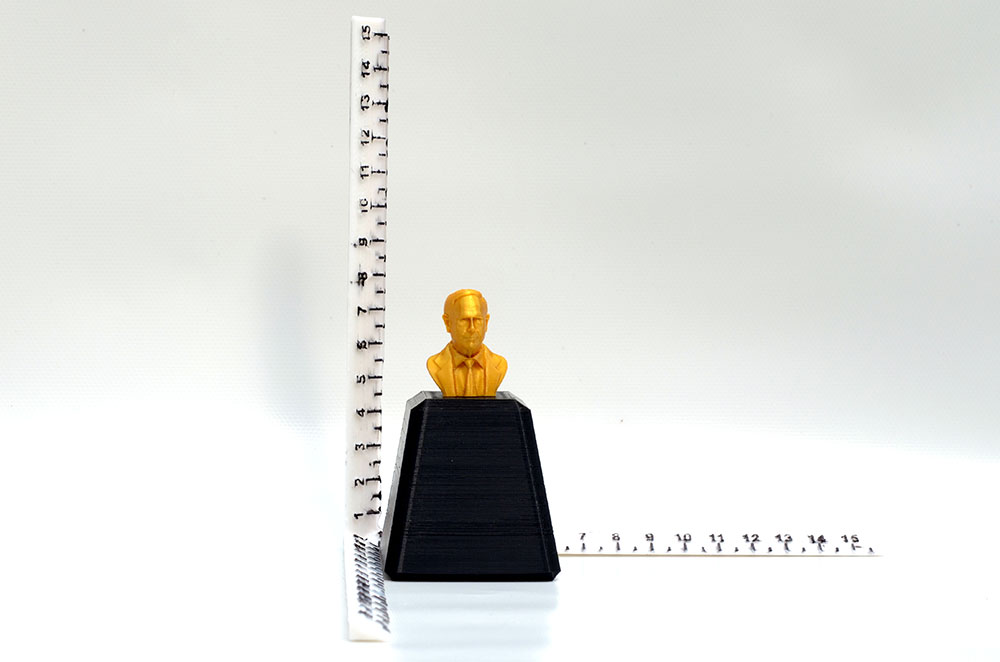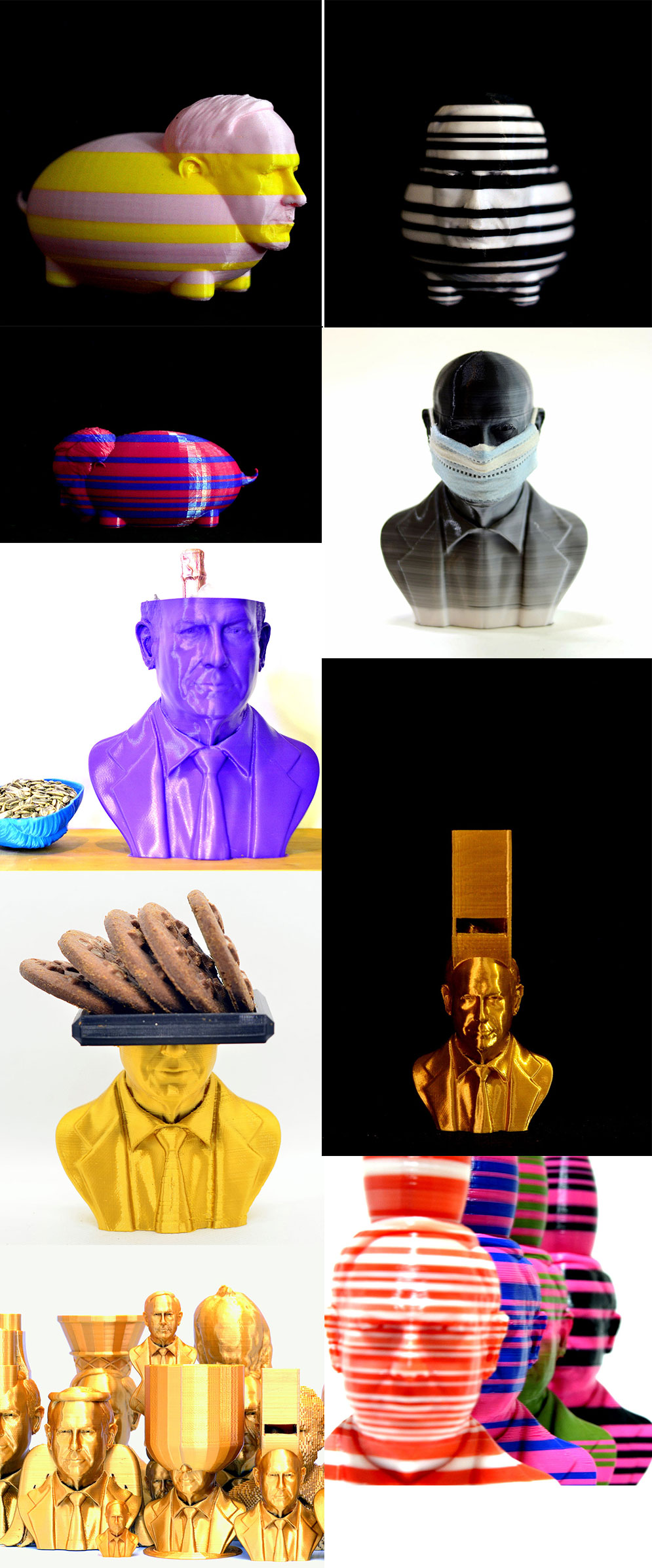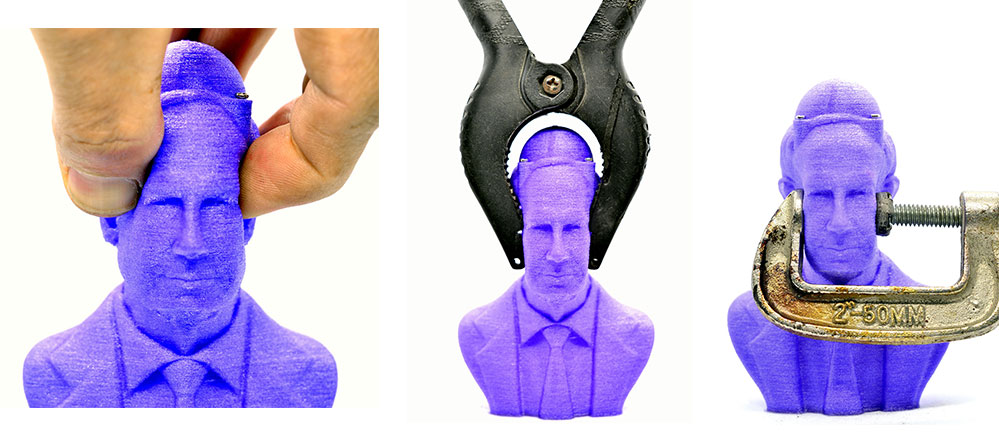The Benjamin Netanyahu Research Laboratory: A Political Design Experiment in 3D
Published 20 April 2025 by Atar Brosh
Since 2019, designer and researcher Atar Brosh has been running The Benjamin Netanyahu Research Laboratory, an ongoing political-design experiment exploring the symbiotic relationship between technology, design, and politics in Israel’s complex socio-political landscape.
Atar Brosh is a designer, senior lecturer, and researcher at the Jerusalem Multidisciplinary Academic center, working at the intersection of sustainable production, parametric design, and digital fabrication. His practice critically engages contemporary culture and technology, blending artistic inquiry and practical experimentation, and has been presented internationally.
Operating out of Tiny Factory, Brosh’s compact home-based studio and digital fabrication lab in Tel Aviv, the project employs accessible digital tools—such as parametric modeling, additive manufacturing, and free open-source software—to rapidly large scale one-of-a-kind artifacts \products. These creations function as souvenirs based on short-term memory, responding in real-time to the continuous presence and influence of Prime Minister Benjamin Netanyahu. The lab serves not only as creative commentary on Israeli politics but also as an exploration into how contemporary designers can critically engage with public discourse through one of a kind yet potentially huge scale, real-time manufacturing.
Tel Aviv, correspondance.

Somewhere between a home workshop and the nightly news, The Benjamin Netanyahu Research Laboratory began. It wasn’t planned as a project. It simply started — one object, one version, then another. It was 2019, Israel was in mid-crisis, and the same figure kept appearing everywhere: on screens, in speeches, in courtrooms, in memes. Ubiquity turned into material. The image became editable.
I calculate and find the amazing fact that Benjamin Nethanyahu is the prime minister of 17 years of my adult life, 55% of my life was under in some way or another, I was try to estimate his influence, by purpose and just by third hand media coverage.
Using 3D printers, parametric modeling tools, and the corner of a worktable, the lab began producing small objects in response to the political atmosphere. A figurine here, a candelabra there, sometimes a toy submarine, a travel-sized bust, or a voodoo doll. Some functional, some ceremonial, some entirely useless. What connected them all was not satire alone, but the speed of response — and the sense that repetition had become the message.

The lab operates in a space where design meets protest, where fabrication is not about optimization but observation. Each object is a kind of timestamp — a short-term memory molded into form. Not always clear, not always fair, but always reacting. The work doesn’t claim neutrality, nor does it attempt to summarize. It reflects a fragmented moment using the only available tools: low-cost machines, off-the-shelf software, and a stubborn need to make something physical out of the blur.
What follows is a selection of these artifacts. Some were made overnight, others over weeks. Most were built before October 7, 2023, though all now carry the weight of what came after. Taken together, they offer no single statement — only a layered archive of absurdity, admiration, anxiety, and critique.
This is not a tribute. It is not a campaign. It is an evolving cabinet of curiosities from a time and place where politics became plastic — and design tried to keep up.

The Lab Setup: No Walls, No Budget
The Benjamin Netanyahu Research Laboratory was never an official institution. It operated from a small home studio with no budget and no staff — only one person, a laptop, and a few consumer-grade 3D printers. The goal was never efficiency. The goal was presence. The lab functioned like a seismograph, responding to political tremors as they happened — printing when others were posting, fabricating when others were fuming.
The workflow was deliberately simple: a political event occurs — a speech, a scandal, a tweet — and a design begins. Within hours or days, a model is produced in CAD, adjusted with a mix of humor, symbolism, and frustration, and printed in physical form. Sometimes it worked. Often it didn’t. But the process became a practice — like keeping a journal, but in plastic.


Technology as commentary
The lab’s core tools were parametric design, additive manufacturing, and an open-source approach. But none of these were employed to optimize production. Instead, they were used to slow things down — to translate a constant media stream into tangible, awkward, often impractical objects.
As McLuhan put it, the medium is the message. In this case, the medium — 3D printing — becomes both content and critique. It undermines traditional political iconography by allowing a single figure to be endlessly reshaped, resized, and repurposed. Netanyahu is not glorified here. He’s versioned. He’s iterated. A digital puppet caught in a cycle of transformation, much like his public persona.
Elaborate
Since 2019, I’ve found myself in a unique, perhaps strange, relationship with the political figure of Benjamin Netanyahu—not out of direct political alignment or opposition, but rather out of a prolonged exposure that has permeated almost every aspect of my adult life. It struck me one day: Benjamin Netanyahu had been Prime Minister for 17 years—approximately 55% of my adult life. His face, voice, and rhetoric had become unavoidable, woven into daily life through screens, newspapers, protests, casual conversations, and even personal reflection.
This awareness led me to establish what I called “The Benjamin Netanyahu Research Laboratory,” a somewhat ironically named initiative. The name itself carried a dual meaning—part parody of an institutionalized academic body, part genuine inquiry into the phenomenon of one person’s overwhelming media presence and its cultural implications.
My lab was modestly equipped with accessible tools emblematic of post-industrial design: consumer-grade 3D printers, open-source parametric modeling software, and basic workshop materials. These were intentionally chosen—low-cost, easy to operate, and capable of fast responses. This choice was driven by necessity and ideology: I wanted to embody the ethos of decentralized production, democratic accessibility, and immediacy of response characteristic of the Fourth Industrial Revolution.

Every artifact produced in the lab was triggered by real-time events—political scandals, election cycles, media spectacles, or speeches by Netanyahu himself. My process became something akin to a ritual. I would read or watch an event unfold, often saturated in intense public debate, and then retreat to my studio to quickly model a three-dimensional response. This might manifest as a candle holder shaped as Netanyahu standing behind a podium, emphasizing the ritualistic quality of his speeches. Or it might become a bath toy submarine—an ironic response to a naval procurement scandal. Sometimes the objects were intentionally provocative, like a voodoo doll, symbolic of collective frustration, or a “Pickle of the Nation,” embodying the idea of cultural fermentation and political stagnation.
In creating these objects, my intention was never to simply mock or support. Instead, I sought to materialize a collective short-term memory—a cultural snapshot of fleeting but intense reactions to political moments. Each artifact became a tangible timestamp, a physical reminder of otherwise transient emotions and discussions.
However, the tone and meaning of this practice changed dramatically following the events of October 7, 2023. Israel experienced profound trauma, and the artifacts I’d produced before took on entirely new dimensions. What was once absurd or ironic now seemed deeply prescient and disturbingly resonant. I found myself facing the reality of how these playful objects could hold deeper meanings and profound implications in times of crisis.
This shift led to reflection and a pause in my practice. I recognized the broader implications of what I’d created: these weren’t merely souvenirs of short-term memory—they were artifacts of a deeply unstable political and cultural landscape. My work, through playful design, had unwittingly captured the inherent volatility of Israeli politics, the fragility of public discourse, and the unpredictability of collective emotional response.
Israel’s unique socio-political landscape significantly influenced this project. It is a nation marked by contradictions and constant tension—between democracy and security, secularism and religion, innovation and tradition. Israeli society is perpetually negotiating its identity amid ongoing conflicts, external threats, and internal divisions. Netanyahu himself has come to symbolize many of these tensions, embodying the complexities and polarities of contemporary Israeli politics. His political career, marked by both fierce loyalty and fierce opposition, has amplified societal divisions and debates on democracy, governance, and national identity.

My work in The Benjamin Netanyahu Research Laboratory reflects these tensions directly. Each object, initially created as an immediate, instinctive response to daily political shifts, gradually revealed itself as a deeper exploration of Israel’s collective psyche. Objects initially interpreted as humorous or trivial gradually acquired layers of meaning, reflecting anxieties, hopes, and cultural contradictions. By giving physical form to these fleeting, often ambiguous moments, the project illuminated the fragility and volatility that characterizes contemporary Israeli life.
Today, The Benjamin Netanyahu Research Laboratory stands as more than a playful, ironic title. It’s a living archive—a design-oriented reflection on a specific moment in history, where politics and digital production converged unpredictably. Each artifact remains a quiet statement, neither entirely serious nor purely satirical, but a genuine attempt to give form to the often chaotic, ephemeral experience of political life in Israel. Through this ongoing exploration, I’ve discovered the profound capacity of design to speak where traditional language often falters, providing a physical anchor to the fleeting emotions and narratives that define our contemporary existence.
Post October 7.23 Recalibration
After the events of October 7, 2023, the entire archive changed tone. What was once ironic became tragic. Objects that once seemed silly now felt loaded. In hindsight, many of them read like warnings — too absurd to be real, too real to be ignored.
In response, the lab stopped producing and started watching. The newer pieces remain silent. There are fewer jokes now. The weight of current events pulled the work inward. What remains are the objects — and the question: can design still speak, when words begin to fail?
The work of Atar Brosh is featured on his YouTube channel TagMeNot design lab and on Instagram
